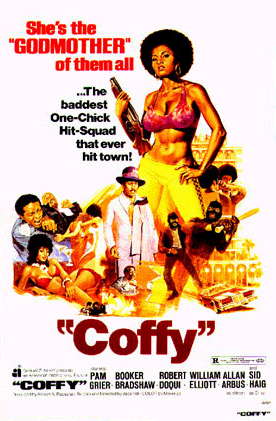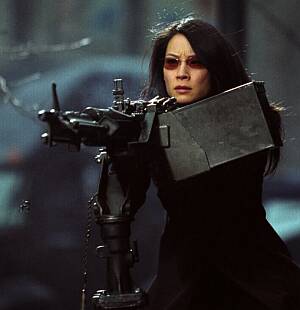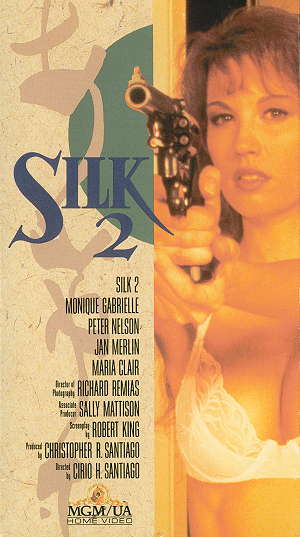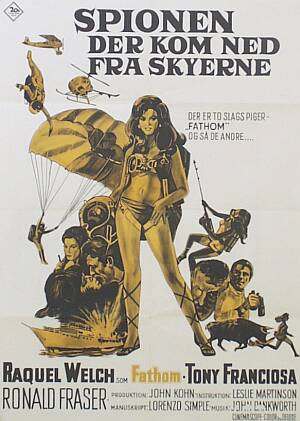★★★
“Hardsuits, rogue mecha and day jobs.”
 Worthy of note as one of the first pieces of anime made available to an English-speaking audience, (not long after its original 1985 Japanese release), BGC is set in 2032, when Tokyo has been rebuilt, post-earthquake. The Genom corporation are fiddling with Boomers, biomechanical robots of immense strength but with a nasty tendency to run amok. Standing guard are a mysterious team, the Knight Sabers, with their own technological strengths, who alternate between merc work and more altruistic concerns.
Worthy of note as one of the first pieces of anime made available to an English-speaking audience, (not long after its original 1985 Japanese release), BGC is set in 2032, when Tokyo has been rebuilt, post-earthquake. The Genom corporation are fiddling with Boomers, biomechanical robots of immense strength but with a nasty tendency to run amok. Standing guard are a mysterious team, the Knight Sabers, with their own technological strengths, who alternate between merc work and more altruistic concerns.
Any similarity to Blade Runner is entirely deliberate; the heroine is called Priss, and sings with a band called The Replicants. She, and her three colleagues (Nene, Linna, and Sylia) moonlight from their various day-jobs as the Knight Sabers, each with their own special abilities. The eight episodes in the series combine multiple plot arcs and standalone stories, with mixed effectiveness, though the later ones tend to work better. There’s not much background on the characters, save Sylia, and a tendency to gallop through towards the final fight in a number of the OAVs. There’s a lot of emphasis on the music, but I’m no J-Pop fan, so they needn’t have bothered.
The animation looks a little creaky now, as you’d expect from a show of its age, but also seems to improve as the series progresses – the artists learn what works and what doesn’t. I confess to preferring secondary characters such as Nene, to supposed heroine Priss; when we get to see their lives (as in #8, which has Nene acting as “babysitter” to a teenage girl on a quest to photograph the Sabers), it’s a more fully satisfying experience. Followed by two sequels, Bubblegum Crash and Bubblegum Crisis 2040.
Dir: Various
Star (voice): Kinuko Ohmori, Akiko Hiramatsu, Michie Tomizawa





 Neither star Grier nor director Hill were exactly strangers to the world of exploitation when they made this, but their combination here created a whole new subgenre, crossing action heroineism with black cinema. Following her would come Foxy Brown, Cleopatra Jones and the rest, but let it be said, Coffy was the first of any significance.
Neither star Grier nor director Hill were exactly strangers to the world of exploitation when they made this, but their combination here created a whole new subgenre, crossing action heroineism with black cinema. Following her would come Foxy Brown, Cleopatra Jones and the rest, but let it be said, Coffy was the first of any significance.
 Proof positive that a lack of narrative coherence is no barrier to a good time, She makes about as much sense as you’d expect from a film where the soundtrack veers wildly from Rick Wakeman to Motorhead. It’s post-apocalyptic sword and sorcery, with Bergman as She, the immortal goddess ruling a tribe of Amazon warriors. For reasons which are never explained, She ends up tagging along with hero Tom as he searches for his kidnapped sister. Hey, even Immortal Goddesses need some time off, I guess.
Proof positive that a lack of narrative coherence is no barrier to a good time, She makes about as much sense as you’d expect from a film where the soundtrack veers wildly from Rick Wakeman to Motorhead. It’s post-apocalyptic sword and sorcery, with Bergman as She, the immortal goddess ruling a tribe of Amazon warriors. For reasons which are never explained, She ends up tagging along with hero Tom as he searches for his kidnapped sister. Hey, even Immortal Goddesses need some time off, I guess. One of the primary rules of exploitation cinema, is never to trust a movie with painted box-art. And, verily, no scene like the picture at right occurs in the film. Indeed, the whole film is sold on sizzle rather than steak, and will probably leave you feeling more than a little hungry. Verrell looks the part, though her slicked-back hair is rather too cliched and obvious, and she does appear to be doing her own action. Her lack of acting ability is painfully obvious, however, and Santiago is wise to keep her dialogue to a minimum.
One of the primary rules of exploitation cinema, is never to trust a movie with painted box-art. And, verily, no scene like the picture at right occurs in the film. Indeed, the whole film is sold on sizzle rather than steak, and will probably leave you feeling more than a little hungry. Verrell looks the part, though her slicked-back hair is rather too cliched and obvious, and she does appear to be doing her own action. Her lack of acting ability is painfully obvious, however, and Santiago is wise to keep her dialogue to a minimum. Despite the title, this movie rarely pits Ecks (Banderas) vs. Sever (Liu). The two spend more of the film teamed, up taking on the evil duo (Henry and Park) who killed Sever’s family and have kidnapped Ecks’ son – perhaps a spoiler, but anyone who didn’t see that one coming, was probably run over on the way to the cinema.
Despite the title, this movie rarely pits Ecks (Banderas) vs. Sever (Liu). The two spend more of the film teamed, up taking on the evil duo (Henry and Park) who killed Sever’s family and have kidnapped Ecks’ son – perhaps a spoiler, but anyone who didn’t see that one coming, was probably run over on the way to the cinema. Was the world really crying out for a sequel? I guess Silk proved profitable enough for Gabrielle to replace Verrell as the titular cop, three years later and without any explanation. I’ve liked Gabrielle since her barnstorming double role in Deathstalker II, but even I have to admit she’s not really well-cast here, with her voice inappropriate for a supposedly tough crimefighter. Mind you, anyone would have problems with cliched aphorisms of the “Crime doesn’t pay” kind demanded by the dialogue.
Was the world really crying out for a sequel? I guess Silk proved profitable enough for Gabrielle to replace Verrell as the titular cop, three years later and without any explanation. I’ve liked Gabrielle since her barnstorming double role in Deathstalker II, but even I have to admit she’s not really well-cast here, with her voice inappropriate for a supposedly tough crimefighter. Mind you, anyone would have problems with cliched aphorisms of the “Crime doesn’t pay” kind demanded by the dialogue.
 Purely on a historical level, this 1985 film merits attention since it started the whole action-heroine genre in Hong Kong cinema, which thrived for the next decade, producing some of the finest entries ever made. It also was, effectively, the start of the careers of Michelle Yeoh and Cynthia Rothrock. Interesting to see how they’ve since headed in opposite directions: Rothrock to low-budget erotic thrillers, Yeoh to the Academy Awards.
Purely on a historical level, this 1985 film merits attention since it started the whole action-heroine genre in Hong Kong cinema, which thrived for the next decade, producing some of the finest entries ever made. It also was, effectively, the start of the careers of Michelle Yeoh and Cynthia Rothrock. Interesting to see how they’ve since headed in opposite directions: Rothrock to low-budget erotic thrillers, Yeoh to the Academy Awards. Released five years before Jennifer Garner was even born, there are some odd similarities between this 1960’s time-capsule and Alias:
Released five years before Jennifer Garner was even born, there are some odd similarities between this 1960’s time-capsule and Alias: As you can probably surmise from the title, this is most emphatically
As you can probably surmise from the title, this is most emphatically